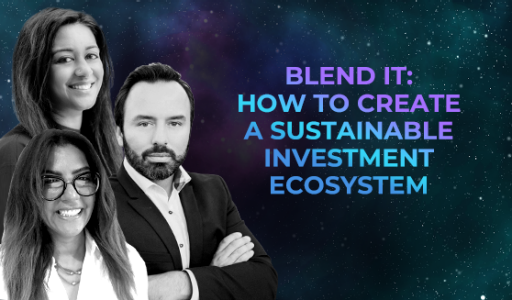
“We can mobilise money into the Middle East and Africa, but unless we have that reliable pipeline of investible startups, we are not going to get anywhere.”
The tech industry often puts the responsibility for securing investment very heavily on the shoulders of startup founders. But in reality, investments depend on a robust, sustainable economic landscape – and when the ecosystem isn’t there, investors can’t be sure they’ll get a solid ROI.
At #LEAP22, Bina Khan (Strategic Advisor and Investor at Summit Venture Partners) got together with a top-tier FinTech leader, and a serial startup founder, and asked them to weigh in on how the Middle East and North Africa (MENA) can develop that ecosystem and drive more tech investments.
What are the obstacles to investment in the region?
Noha Shaker (Founder and Secretary General at Egyptian FinTech Association) pointed out that the MENA region has always been under-served – not just by financial services, but by services in general.
She’s not wrong. Research by the IMF, published in 2003, found that at that time the MENA region ranked well below the industrialised countries, but above most other developing regions. Interestingly, despite ranking well above East and Southeast Asia (which had just become industrialised economies) in the 1960s, the MENA region then fell behind them in the 80s and 90s.
However, in 2022, change is happening fast. The global shift to digital and rapid acceleration of tech development is offering new opportunities, and Ferid Belhaj (World Bank Vice President for Middle East and North Africa) has been encouraging the MENA region to jump on those opportunities – or risk missing ‘the fourth industrial revolution’.
Figures published in a press release by financial consulting firm EY indicated that 2021 was a historic year for MENA markets, with USD $7.9 billion raised through 21 IPOs. The bulk of that activity (amounting to $5.6 billion) happened in Q4 alone. The biggest IPO in the region was in Saudi Arabia, where the International Company for Water and Power Projects (ACWA POWER Co) raised $1.2 billion, and its stock price surged by 30%.
One of the various factors at play in this upturn are entrepreneurs themselves. Sky Kurtz (CEO and Co-Founder at Pure Harvest Smart Farms) pointed out that historically, the region has imported talent heavily; “but over many years they’ve been building the research institutions, the capabilities, and now some very successful companies that have ascended in the region have created a ton of highly trained entrepreneurs that are now spilling into the ecosystem.”
Those new homegrown entrepreneurs are now entering new companies, or starting their own. A lot of the early employees of Dubai-based app startup Careem have now founded successful startups, as reported by Forbes in 2021 – most with valuations in the multi-millions, and some already in billions.
And according to Shaker, the fact that the region has been so under-served is now becoming an opportunity in itself. It’s a huge market of millions of individuals, and hundreds of thousands of SMEs, that are under-served in financial services; but also in key services including education, healthcare, and digital commerce. “That represents an opportunity,” Shaker said, “being under-served is an opportunity for investors, [and] it’s an opportunity for startups who actually have what it takes to build and serve the market.”
Blended capital will drive stability in the MENA investment ecosystem
For any startup seeking investment, there are three types of capital that might be available:
– Philanthropic capital, which is usually given as a grant by organisations with a particular mission, to fund research and development by startups in their field – with little or no expectation of ROI.
– Development capital, which Shaker also called “patient capital”; it’s given to drive business development, and the investor does expect a return, but there isn’t usually a tight timeline for that return to materialise.
– For-profit capital, which is purely for making money – with an expectation of a high ROI within a short timeframe.
“One thing that sometimes entrepreneurs, especially in the scientific field, do not keep in mind is the lead time from actually having an idea and then developing that technology and then commercialising it. They seek for-profit capital really early on.”
Instead, Shaker urges startups to seek blended capital: a mixture of these three types. Because in spite of billions being directed into the region to support startups, there’s still a gap – especially in really early-stage investments.
“Just imagine,” Shaker proposed, “that you blend some of the capital.”
Philanthropic capital drives r&d, the development capital drives the business to growth point, and then for-profit capital drives growth, expansion, and profit. The for-profits put money into proven ideas, the philanthropists get to put their funds into projects that align with their mission, and the development capital funds get to invest at a point when r&d has already happened in a serious way so the business is ready to develop. Everyone wins.
Kurtz pointed out that capital isn’t the only thing that should be blended: startups in the region should also consider partnerships and collaborations with other companies to enable them to scale at pace. Not every entrepreneur should focus solely on new inventions – some need to borrow, buy, or share ideas.
“This idea that we need to build a novel-everything isn’t true,” Kurtz said, “and it will slow us down. Instead, look to the world where you can buy or partner or borrow great ideas, and create that success and that traction, and it will make it easier to attract capital and grow your business.”
So entrepreneurs need to collaborate – and so do investors.
“I would ask every organisation to have an investment arm to offer support to startups,” Shaker said. “I would encourage every high-net-worth individual, every family office, to have some philanthropic capital that is directed towards r&d.”
And crucially, “I would definitely encourage the VCs and the for-profit money to seek the partnerships and work together with everybody, to create value for everyone, and drive the pipeline of startups on the ground that we currently miss. We can mobilise money into the Middle East and Africa, but unless we have that reliable pipeline of investible startups we are not going to get anywhere.”








